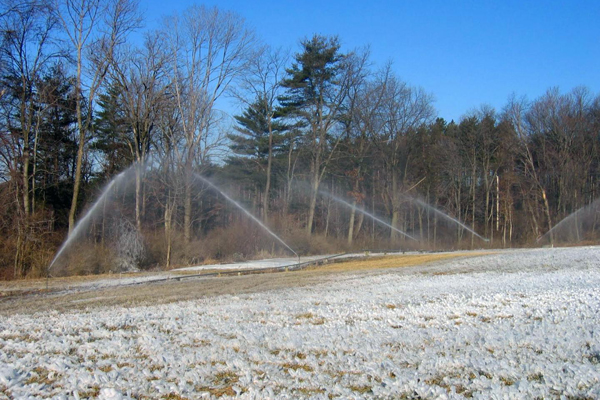Evaluating wastewater reuse with the “Living Filter”
December 8, 2014 - Adityarup “Rup” Chakravorty
Less than a mile from the edge of the bustling Penn State University campus lies 600 acres of cropland and forests crisscrossed with irrigation pipes. The water being pumped out of these pipes isn’t channeled from a river or a well. Instead, over 500 million gallons of treated wastewater from the campus is discharged at this site every year.

This "Living Filter" wastewater reuse system was started in the 1960s. The long-term irrigation of the land with treated wastewater provides scientists with an ideal research site. They can study how compounds in wastewater accumulate in the environment and whether soils can filter chemicals before they reach groundwater.
Emily Woodward and colleagues at Penn State University recently measured the levels of three chemical compounds in the soils at the Living Filter site. Their work was published in the November-December issue of the Journal of Environmental Quality. For the study, the researchers took samples from the vadose zone. This soil layer lies between the soil surface and the groundwater table. The goal was to determine whether chemicals in the wastewater used for irrigation were accumulating in the vadose zone and therefore staying out of groundwater.
The chemicals that Woodward and her colleagues studied are endocrine disrupting compounds, or EDCs. Two of the three chemicals, 17β-estradiol and estrone, are hormones naturally produced by humans and other animals. The third chemical, 17α-ethynylestradiol, is a synthetic compound in birth control medication.
Birth control pills are often disposed of down the sink or flushed down toilets. Across the United States, that wastewater is treated and then usually discharged directly into streams or rivers. Though the wastewater is treated it still contains chemicals, including EDCs that may affect how our hormonal systems work.
The exact repercussions of EDCs on human health remain unclear, but they have been shown to feminize male fish and decimate fish populations. Says Woodward, “I think we all can agree that we don’t want be exposed to hormones through our environment and drinking water.”
Woodward found that soil samples from the Living Filter site contained higher concentrations of estrone and 17β-estradiol compared to samples taken from a non-irrigated site. Concentrations of 17α-ethynylestradiol were generally the same at both irrigated and non-irrigated sites.
Within the Living Filter, accumulation of EDCs in the soil depended on land use. Forested soils accumulated higher levels of EDCs compared to the soil in areas being used for agriculture.
One important difference between soils in the croplands and forests of the Living Filter is the amount and quality of organic carbon present. “If you have a lot of organic carbon in the soil then the compounds are going to bind to the organic carbon and not move as rapidly through the soil,” explains Woodward. Forested soils had almost three times the amount of organic carbon as the agricultural soil, which might explain the increased accumulation of EDCs in these soils.
As a next step in the research, Woodward is now measuring EDC levels in wells near the Living Filter site. These measurements will provide a direct indication whether the soil is filtering the EDCs and preventing groundwater contamination.
Woodward is excited by indications that spraying treated wastewater on soils is acting as a filter for potentially dangerous chemicals. As more and more wastewater is used for irrigation and groundwater recharging, “we need to understand what compounds are in [the wastewater], and how they are behaving in the soil when they are applied,” she says.
